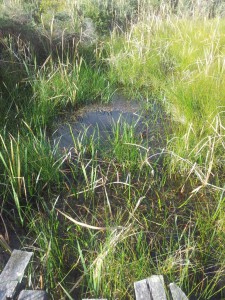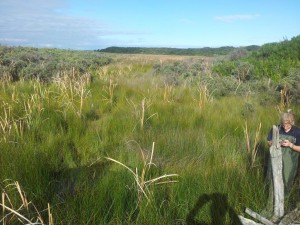Revisiting Long Swamp – brought to life by stories of the past
If you have an interest in natural history, isn’t it great to listen to the detailed reflections of an elderly person sharing their memories of a place that has undergone dramatic change?
I remember as a child growing up in the western suburbs of Adelaide, hearing an elderly neighbour (Mrs Pape) describe a flood of the Adelaide Plains in the 1920s that was so significant (prior to the artificial drainage outlet channel being cut for the River Torrens to the sea) that people were rowing boats to travel down Marion Road near the airport. My maternal grandmother (Mary Stella Carson) told me that around the same time in the 1920s she caught a tram to Henley Beach and, having just relocated from Hammond, beyond Goyders line in the mid-north (now a ghost town), she couldn’t believe the amount of water seen everywhere during parts of the journey to the coast.
Although a totally different location, it was during the same era in the 1920s, that Edna (now 94) and Joan (now 84) Millhouse’s father purchased a farm near Nelson, adjacent to Long Swamp. These sisters have many interesting stories to share from their summers spent on this isolated stretch of coast in the 1930s and 1940s. Learning to swim in a deep spring-fed pool in Eel Creek within Long Swamp where they also used to see large Tench (fish) swimming, flat-bottomed boat trips up the swamp, and long walks along the coast as far as Nobles Rocks, were some of the productive ways the girls spent their youth in the great outdoors.
So what can their observations tell us about Long Swamp?
Well, the deeper spring-fed pool where they learned to swim is certainly still there, with the bottom not visible due to the algal growth obscuring the view…

The spot where the Millhouse sisters learned to swim (with the leeches and fish) in the 1930s and 40s
But the environmental change in the swamp itself has been dramatic. The swamp that they remember as having significant stretches of open water and being navigable by boat for a considerable trip upstream, is still wetland habitat, but has transitioned to become a densely vegetated reedbed – see below.
The sisters also remember the day in the 1930s when they came across a small outflow to the ocean at Nobles Rocks, where they had never seen water exit the swamp before. They didn’t think too much of it at the time, but this minor outflow (that all evidence at the time they felt suggested was cut by eelers) soon became (through the erosive force of water flowing through sand) the major discharge site that is has now been from the swamp for approximately the past 75 years.
The sisters attribute the subsequent changes they noticed in Eel Creek, the Glenelg Estuary and throughout Long Swamp to this upstream diversion of water directly to the sea. And they weren’t alone in that opinion…
By the 1950s, a bloke called “Sinker” (an angling enthusiast), was reporting on the moves being made by the Glenelg River Angling Club, to have two artificial outlets from Long Swamp re-diverted to the Glenelg River. This would indicate that sometime between the 1930s and the 1950s, the former outlet at White Sands was also artificially cut through to the sea, because the Millhouse sisters weren’t familiar with this second smaller drainage outlet – although they did remember a location where the swamp came closer to the sea, and the sand wasn’t formed into high dunes but water occasionally spilled over a wide, flat area of the beach and into the ocean when swamp water levels were very high. After decades of sand movement building the dunes we now identify at this location, I think this must now be the place we know as White Sands.
To wrap up this little historical snippet, please have a read of the article below written by “Sinker” – it has some fascinating insights… but that will do for today – I’ll return to the story to provide an update on how the Angling Club went with their 1953 endeavours in a future blog!



